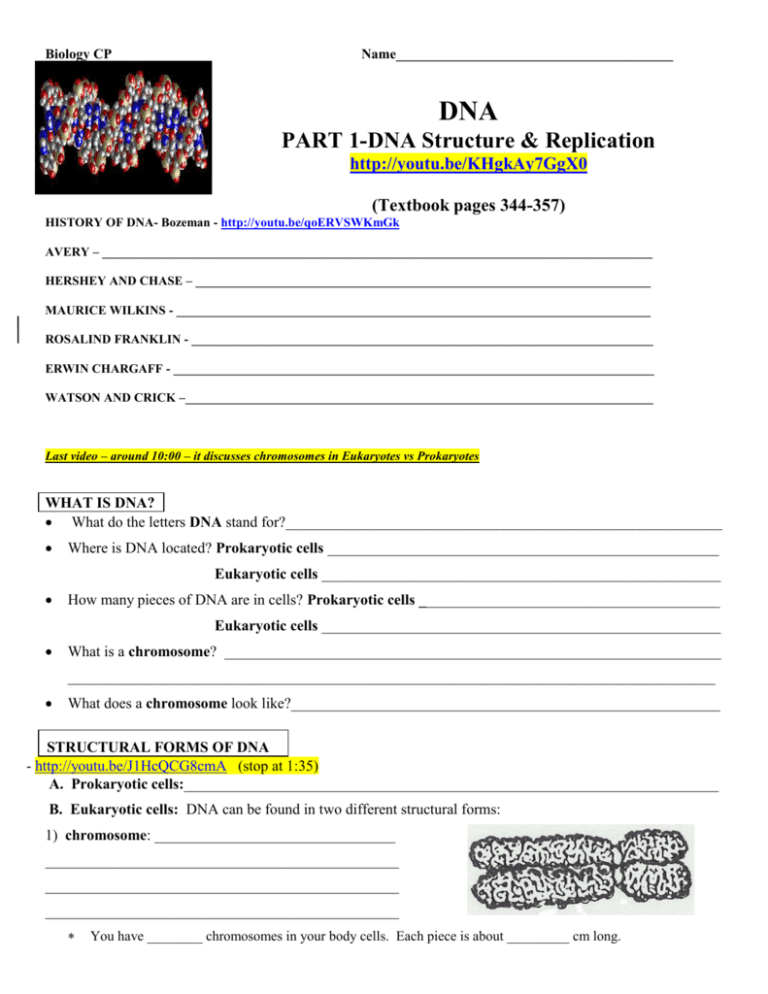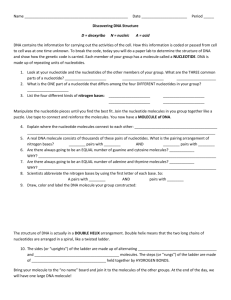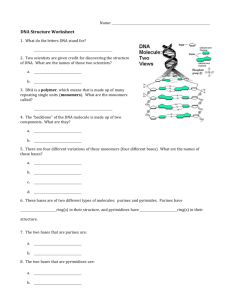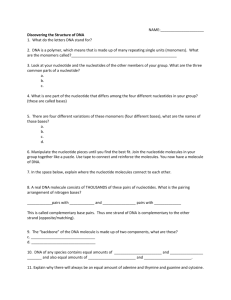Systems Biology Notes (Chapter 15, pp
advertisement

Biology CP Name________________________________________ DNA PART 1-DNA Structure & Replication http://youtu.be/KHgkAy7GgX0 (Textbook pages 344-357) HISTORY OF DNA- Bozeman - http://youtu.be/qoERVSWKmGk AVERY – _______________________________________________________________________________________ HERSHEY AND CHASE – ________________________________________________________________________ MAURICE WILKINS - ___________________________________________________________________________ ROSALIND FRANKLIN - _________________________________________________________________________ ERWIN CHARGAFF - ____________________________________________________________________________ WATSON AND CRICK –__________________________________________________________________________ Last video – around 10:00 – it discusses chromosomes in Eukaryotes vs Prokaryotes WHAT IS DNA? What do the letters DNA stand for?__________________________________________________________ Where is DNA located? Prokaryotic cells ____________________________________________________ Eukaryotic cells _____________________________________________________ How many pieces of DNA are in cells? Prokaryotic cells ________________________________________ Eukaryotic cells _____________________________________________________ What is a chromosome? __________________________________________________________________ ______________________________________________________________________________________ What does a chromosome look like?_________________________________________________________ STRUCTURAL FORMS OF DNA - http://youtu.be/J1HcQCG8cmA (stop at 1:35) A. Prokaryotic cells:_______________________________________________________________________ B. Eukaryotic cells: DNA can be found in two different structural forms: 1) chromosome: ________________________________ _______________________________________________ _______________________________________________ _______________________________________________ You have ________ chromosomes in your body cells. Each piece is about _________ cm long. What is the total length of DNA in one body cell? _______________ meters! How does that much DNA fit inside each of your cells? ______________________________________________ Histones are proteins which act like thread spools. DNA is wound around the histones in order to fit inside a cell. 2) chromatin: __________________________________ _______________________________________________ _______________________________________________ _______________________________________________ Why have 2 different forms of DNA in your cells? a) The advantage of chromosomes is _________________________________________________ ______________________________________________________________________________ b) The advantage of chromatin is ____________________________________________________ ______________________________________________________________________________ Each one of your body cells has an exact copy of DNA. That includes toe cells and nose cells, ear cells and eye cells! DNA vs RNA- Bozeman - http://youtu.be/W4mYwsr9gGE DNA RNA # of strands Name of sugar Names of 4 bases found Location in the cell 2 3 Gene: _______________________________________________________________________________ CHROMOSOME NUMBER Every species of eukaryotic organisms have a specific number of chromosomes in each cell: Organism goldfish chicken horse sand dollar chimpanzee dog human brown bat corn plant housefly fruit fly Number of Chromosomes in each cell. 94 78 64 52 48 48 Why are these numbers so different? 1) _____________________________________________ 2) _____________________________________________ 44 20 12 8 WHAT IS A GENE? Gene: 1) A unit of hereditary information which can be passed on to future generations. 2) ______________________________________________________________________________ ______________________________________________________________________________ 3) Genes hold the code for synthesis of a) proteins ________________________________________________________________ b) polypeptides ____________________________________________________________ c) traits or parts of a trait ___________________________________________________ ________________________________________________________________________ Review of the amino acid structure of proteins: How many different amino acids could be used to form a single protein or polypeptide? ______________ 4 THE STRUCTURE OF DNA Which group of organic compounds does DNA belong to?_______________________________________ Considering that DNA is a long molecule that must periodically be copied, it must be composed of simple units that fit together easily. 1) DNA is made of repeating subunits called _________________________________ 2) Each nucleotide is made up of 3 parts: a) ____________________ b) ________________________ c) _____________________ 3) The sugar and the phosphate groups are identical in all DNA nucleotides but there are four different types of nitrogen bases: c) ___________________________ a) ___________________________ d) ___________________________ b) ___________________________ and STRUCTURES OF THE MOLECULES THAT MAKE UP A NUCLEOTIDE: 1) Deoxyribose sugar: (ribose sugar minus an oxygen molecule) Ribose sugar (found in RNA) O 2) Phosphoric Acid (Phosphate group): HO P OH OH 3) One of four different nitrogen bases: PURINES – DOUBLE RING 1) adenine 2) guanine PYRIMIDINES- SINGLE RING 3) cytosine 4) thymine 5 NUCLEOTIDE: A nitrogen base bonded to a sugar and a phosphate group. Here is an example of a nucleotide: As you can see, the chemical structure of a nucleotide is difficult to draw so we normally draw a nucleotide using symbols/letters to represent the parts. In the diagram above, what does the "A" stand for?______________________________ What other letters could be used in that position?___________________________ In the diagram above, what does the "S" stand for?______________________________ In the diagram above, what does the "P" stand for?______________________________ How many different types of nitrogen bases are there in DNA? ___________ Name them:___________________________________________ If each nucleotide contains ______ nitrogen base, how many different types of DNA nucleotides can be formed? ____________________ NOTE: Another type of nucleotide, Uracil, will replace the Thymine nucleotide in RNA molecules. 6 The drawing below is a MODEL representing a short piece of a DNA molecule. The key identifies phosphates, sugar and nitrogen bases. The bonds that hold the molecules together in DNA are _______________________________________________ The bonds holding the nitrogen bases are NOT covalent but are ____________________________________________ Circle a nucleotide on the drawing above. What does each nucleotide have in common? __________________________________________________ How do nucleotides differ from each other? ___________________________________________________ Notice that each nucleotide bonds with a nucleotide above and below it. This forms a strand of DNA. How many strands make up a molecule of DNA? _______________________________________________ The two strands are then twisted into a spiral shape, double stranded structure called a _______________________________________________________________________________________ 7 8 Look at the model of DNA on the previous page. Use a red, blue, yellow and green colored pencil and follow the directions to answer the questions: 1) Look at drawing A. Circle a nucleotide on the right hand side or strand of the DNA molecule. What three parts can you identify? 1. ____________________ 2. _________________________ 3. __________________________ List the names of the different bases: __________________________________________________ ______________________________________________________________________________ 2) Color the circled nucleotide. Color sugar red and the phosphate blue. What is the name of the nitrogen base that you have circled? ___________________. Color the bases as follows: adenine and guanine-yellow, cytosine and thymine-green. 3) Circle another nucleotide on the left hand strand of the DNA molecule. Color the sugar, phosphorous and nitrogen base as above. 4) Imagine that the molecule of DNA in drawing A looks like a ladder. What two molecules make up the sides of the ladder? ________________________ and ________________________________ 5) What two molecules make up the rungs of the ladder? (Rungs are where you place your feet.) _________________________________ and ____________________________________________ 6) Color the remainder of the DNA molecule in drawing A according to the directions. 7) At what point are the right and left strands of DNA nucleotides joined?________________________ 8) Is there any order to the pairing of the nitrogen bases down the center of the DNA molecule? _________________________________________________________________________________ _________________________________________________________________________________ Is this a pairing of purines with pyrimidines? ____________________________________________ 9) Is there any order to the nucleotides down the right hand strand of the DNA molecule? __________ 10) Is there any order to the nucleotides down the left hand strand of the molecule? ________________ IN SUMMARY: 1) In a molecule of DNA, adenine is always paired with ______________________________ 2) In a molecule of DNA, guanine is always paired with ______________________________ 3) In a molecule of DNA, a purine is always paired with a ____________________________ 4) We call this system of base pairing _________________________________________________ 5) If the sequence of nucleotides in one strand of a DNA molecule is T-A-C-G-G-T-C-A-A, what would be the complementary base pairs on the other strand? ______________________________ 6) Describe the shape of the DNA molecule in drawing B. ________________________________________________________________________________ 7) We call this twisted, double strand shape a ___________________________________________ 9 Who discovered the structure of DNA? James Watson and Frances Crick (1953) __________________________________________________ ____________________________________________________________________________________ Rosalind Franklin (1951) ______________________________________________________________ The Human Genome Project Genome _______________________________________________________________________________ Completed in 2003, the Human Genome Project (HGP) was a 13-year project coordinated by the U.S. Department of Energy and the National Institutes of Health. During the early years of the HGP, the Wellcome Trust (U.K.) became a major partner; additional contributions came from Japan, France, Germany, China, and others. Project goals were to: identify all the approximately 20,000-25,000 genes in human DNA, determine the sequences of the 3 billion chemical base pairs that make up human DNA, store this information in databases, improve tools for data analysis, transfer related technologies to the private sector, and address the ethical, legal, and social issues (ELSI) that may arise from the project. (Source: http://www.ornl.gov/sci/techresources/Human_Genome/home.shtml) 10 DNA Replication https://www.youtube.com/watch?v=5qSrmeiWsuc When and why must the DNA molecule be copied? ____________________________________ This is called__________________________________. The following is a model showing REPLICATION of a very short piece of DNA: List the steps in DNA replication: 1) DNA unwinds and unzips ________________________________________________________________ 2) DNA polymerase helps to link free floating DNA nucleotides _____________________________________________________________________________________ _____________________________________________________________ 3) Covalent bonds join _____________________________________________ ______________________________________________________________ 4) Each new DNA strand formed contains ______________________________________________________________ ______________________________________________________________ Note: If an error is made during replication, what is it called? ________________ 11









